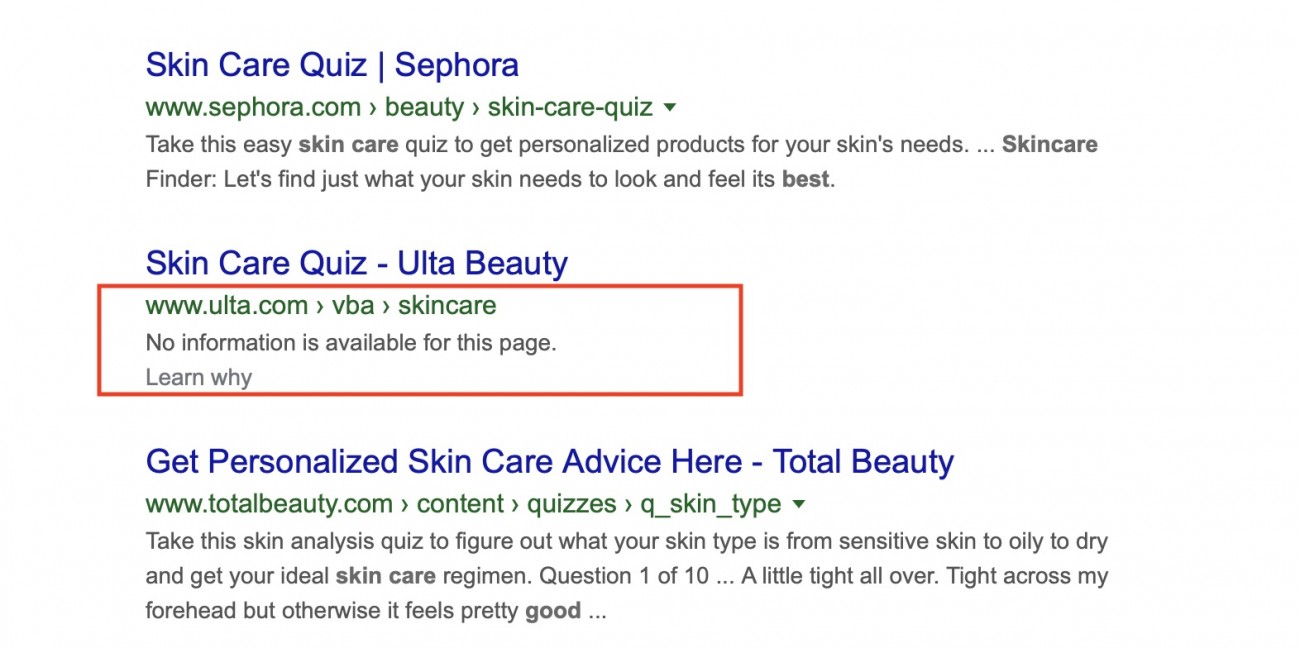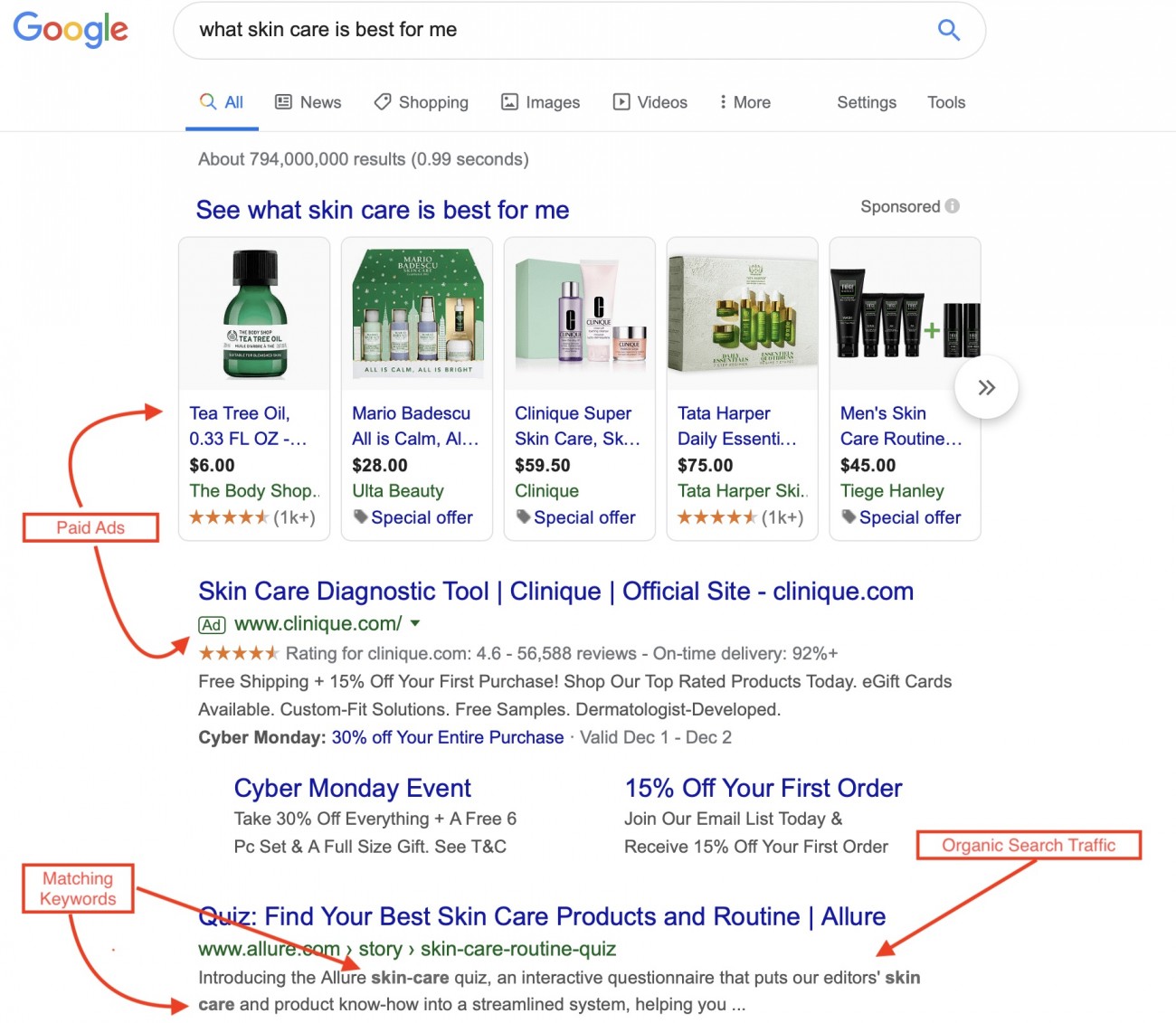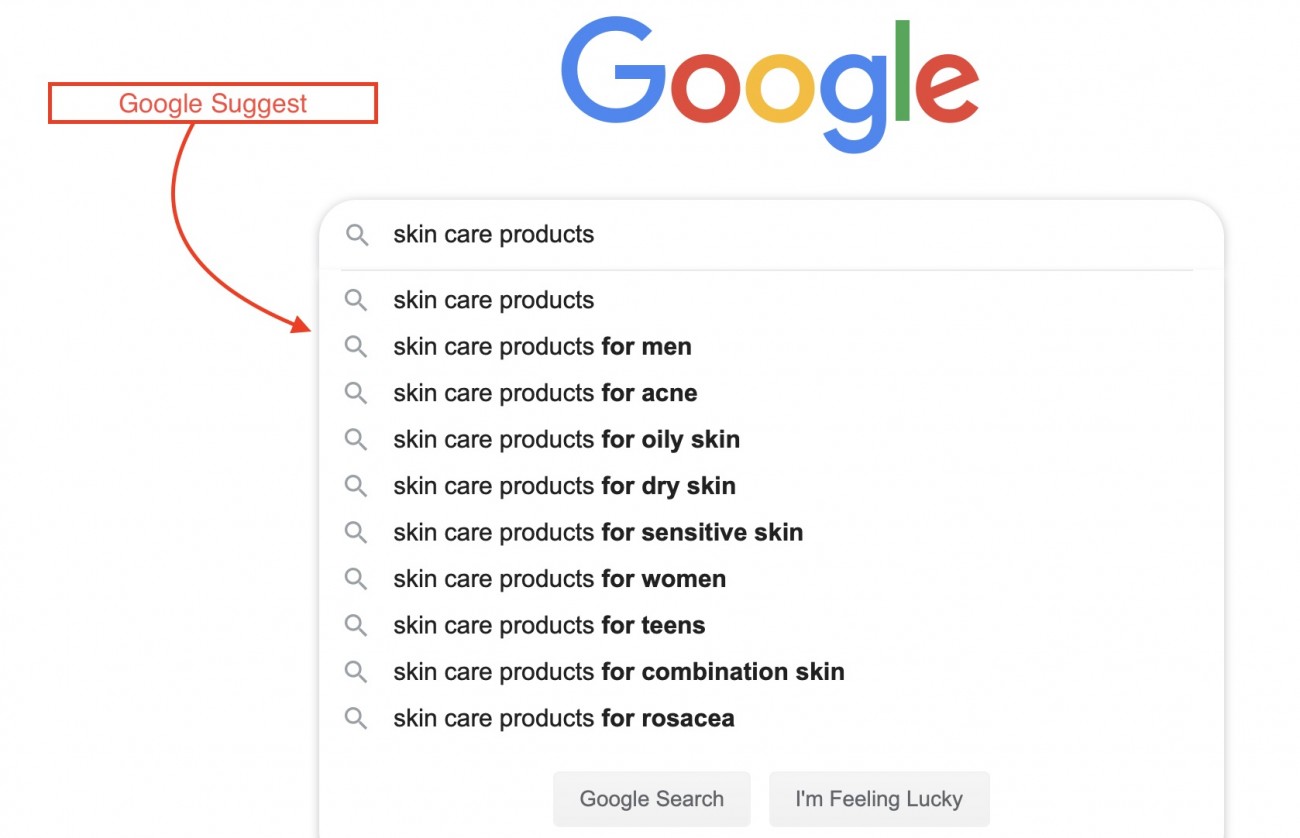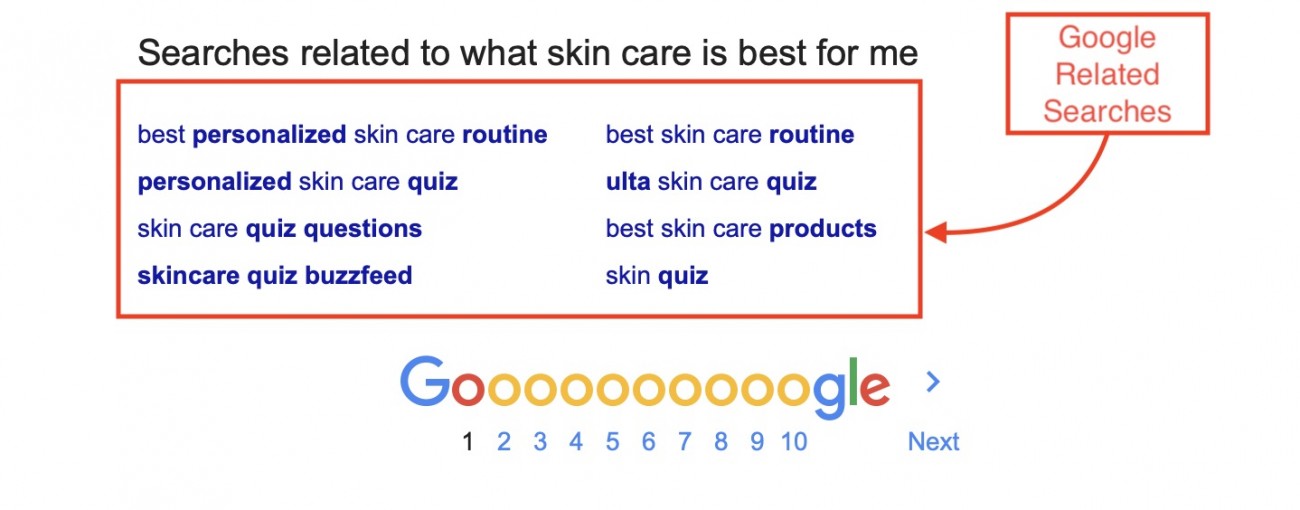KEY TAKEAWAYS
- Improving your speed is vital in ranking high on search engines.
- Adding and maintaining good structured data will improve your appearance to computers.
- Frame your metadata around SEO and long-tail keywords.
- Long-tail keywords are longer keywords with more specific phrases used frequently by visitors close to a point-of-purchase when browsing online or using voice search tools.
- Structure your website correctly with one H1 heading on each web page.
- Include internal, functional links on your pages.
Perhaps, you have spent the time in crafting content for your website, updating all links, adding engaging media, yet you still don't have the kind of target visitors to your site that you are seeking?
According to Andrey Lipattsev, Search Quality Senior Strategist at Google, high-quality content and link building are the two most important signals used by Google to rank your website for search.
While putting valuable and useful content on the pages of your website is paramount, it is important that you first set up your website with the speed, structure data, tags, metadata, and SEO that will increase the right kind of traffic to your site. If you have a wonderful website, but no one ever sees it because Google is not directing search results to your business, you will never achieve the ROI you’re seeking.
How do you fix that?
Generate Quality Traffic to Your Website
One of the backbones of marketing in this digital age is generating SEO (Search Engine Optimization), the attempt to optimize or format your website so that the quantity and quality of traffic increases, thereby providing a competitive advantage, boosting sales and maximizing conversions.
If you need help adding more to your website, here are 10 crucial elements every website should have.
Increase your speed, increase your rankings.
According to one study, the average Speed Index speed is 4.7 seconds on desktop and 11.4 seconds on mobile. Google’s best practice is to have a speed index under 3 seconds.
When your site is slow, your rankings decrease in search engines. If your website is taking longer than 3 seconds to load, not only are you losing your spot in search engine rankings, but you are also losing impatient viewers to competitors with faster e-commerce pages.
There are many helpful tools to help measure your site speed. Consider conducting speed audits with tools like Google Lighthouse or WebPageTest.
You should tack your site’s metrics over time as your site’s speed will fluctuate over time. Plus, if anything is wrong with your site, you will know quickly.
Increase your speed in other ways.
Streamline your page by eliminating any factors that slow down loading speed, like hosting too many assets on every page.
Have you optimized your images?
Sometimes the type of images you add to your pages can slow down your page speed. Optimize your images, video, and media files, so they don’t cause lagging and increase bounce rates.
Heavy images not only slow down your site, but also increase the page weight, causing you to lose viewers, more so even on mobile networks.
Using large PNGs or heavy images will significantly slow down your page speed. The common types of images used online are JPGs (or JPEGs), PNGs, GIFs, and SVGs.
Make sure you reduce the physical image size (dimension) so it is optimized for your pages and site. You can do this in many available image tools.
Save images appropriately, like using Photoshop’s Save for Web feature, so they are preserved in a form for displaying online. And compress your image files. Google has some recommendations too.
You can also implement back-end fixes like improved caching and hosting solutions. Storing your website in browser cache will help increase your download speed on return visits. In WordPress, there are convenient plugins like W3 Total Cache and ZenCache.
Optimize your website for mobile viewing.
Not only will a fast site and good design help you keep your customers, but Google’s smart algorithms will look at your page and analyze all aspects of it to rank it.
Its algorithms figure out whether it is user-friendly or not, whether it functions on desktop and/or mobile, the size of your menus, whether links are functional or broken, the distance between buttons, whether your items properly fit on the screen, and it will analyze and penalize you for it in your SEO rankings. So, if you want to rank better, make sure you keep up with mobile and the other ranking factors found here.
When it comes to generating on-site traffic from organic SEO, or unpaid, algorithm-driven results, understanding and implementing good structured data and meta tags will help set your business up for success.
If you have a wonderful website, but no one ever sees it because Google is not directing search results to your business, you will never achieve the ROI you’re seeking.
Optimize or format your website so that the quantity and quality of traffic increases, thereby providing a competitive advantage, boosting sales and maximizing conversions.
The effective use of structured data.
Structured data formats are rules that standardize the structure and content of any webpage, so that computers can process their meaning or semantics. The markup does not change your website, it just allows the metadata and text to be more meaningful to computers.
Structured data – also known as schema markup – is organized and tagged with unique groups of text which help search engines understand and classify the context, content, and purpose of that information to return more accurate results to searchers.
While it does not directly help your rankings, it will help clearly identify the content of your page, placing your page in the right search queries. It makes it easier for search engine bots to find and index your pages. Learn more about schema markups here.
Using schema can result in increased visibility, improving the appearance of an organic search listing with enhancements, or rich results or snippets, of your content in SERPs, which can improve click-through rates. Think the impact of product images, ratings, prices, and availability, which help your organic listings stand out to searchers.
Take time to buildup the way your site displays correctly, because it is actually a valuable tool that will help drive the right traffic to your site.
Besides page speed which affects your SERP rankings, you can ensure you have the proper keywords needed to connect your site to your target audience. Set up your website with the metadata and SEO that will increase the right kind of traffic to your site.
Optimize your on-site SEO.
Google releases new versions of their algorithms frequently, with updates to its ranking factors. Search algorithms look at many factors, including the words of your query, relevance and usability of pages, expertise of sources, your location, and other settings. The weight applied to each factor varies depending on the nature of your search.
Once implemented, these changes have massive impacts on company rankings overnight, so it is important to keep your site up to date with these requirements in order to generate the desired organic SEO results.
For instance, in 2019, Google upgraded their algorithm and underlying hardware to support the BERT natural language processing (NLP) model. BERT helps Google better interpret natural language searches and understand context. This update negatively impacted unnatural, keyword-heavy results.
Using different kinds of tags tells search engines, social media platforms, and other system how your website should appear, allowing you to customize display features to showcase the right features and improve your targeted traffic.
Frame your metadata around SEO and long-tail keywords.
Metadata
Metadata, or more specifically meta tags, are HTML tags on the backend of websites that store information about the web page but are not displayed on the browser itself. The title and basic description of the page, including keywords relevant to the page are included as meta tags, which search engines use in order to filter results and index web pages, delivering content matched to user queries online. These results are known as search engine results pages (SERP).
Meta tags include both meta titles and meta descriptions. Meta descriptions are the small subtexts that pop up under SERPs. These provide general descriptions of the content of each website page. If you write compelling meta descriptions that accurately describe your content using specific keywords, your page will get quality clicks from users seeking your specific content, increasing conversions.
Improving your use of tags.
E-commerce can offer a host of customized tags, telling computers and programs all sorts of valuable information, including whether items are in stock or on sale, the type of product specified, meta tags for title and description, and other kinds of tags that Google uses.
We all know that meta tags are important but they truly do matter. How you name your pages, doing the right research on keywords, selecting the right ones, organizing them in the right order. All of this plays a role in your SEO.
Having a unique title tag on every page that describes the page will be very important in helping improve your SEO. While the meta description itself does not play a role in SEO, it’s what will determine whether users click on your search result. Use info that will catch users' attention, but keep it within 160 characters. Google supports both page-level meta tags as well as inline directives to help control how your site's pages will appear in Search.
Page-level meta tags are a great way to provide search engines with information about your web site. Meta tags can be used to provide information to all sorts of clients, and each system processes only the meta tags they understand and ignores the rest. While creating meta tags isn’t a ranking factor, the way your page appears on results and social media posts will influence online traffic and subsequently your ranking.
Search engines such as Google use metadata from meta tags to understand additional information about the webpage. They can use this information to display snippets in search results.
Writing compelling meta titles and meta descriptions that accurately describe original, good content with specific keywords will get your page quality clicks from users seeking your specific content, increasing conversions.
The following is an example of a meta title and meta description. Note that each employs a short and keyword-focused, direct approach.
For strategies to help your B2B business shift to a distributed work environment, here are some valuable tips.

When you don’t include meta descriptions, it leaves you at a serious disadvantage, as viewers have no real idea about your page’s content or reliability. Have you ever found search results that looked less than reliable? Crafting meta descriptions that engage your reader and intrigue viewers will generate more traffic.
Viewers have no real idea about your page’s content or reliability. Have you ever found search results that looked less than reliable? Crafting meta descriptions that engage your reader and intrigue viewers will generate more traffic.
Adding tags to your social media can help improve the appearance of your site, posts, and content, including your images and videos.
Using Open Graph tags (OG tags), Schema tags, and Twitter Cards are the typical ways to add social media tags, tags recognized by all major social media platforms including Facebook, Twitter, Google+, and LinkedIn. By pulling information from the meta tags, these apps display your website link accordingly. You can also use Twitter cards to add social media tags for Twitter.
Easily evaluate and visualize your content with Facebook’s Open Graph Debugger, test your schema tags with Google’s Structured Data Testing Tool, or access Twitter’s Card Validator Tool.
By adding these tags, you are tailoring the content of your site for your targeted audiences and platforms, ensuring you establish an omnichannel experience that captivates. When you share on social media, more engaging visuals will improve your share-ability and exposure across social media.
Additionally, a tool like the Chrome plugin meta Tag Analyzer can tell you if your most important meta tags are set up correctly.

If you are a consumer looking for skin care solutions, typing the question “What skin care is best for me?” into a search engine will yield SERPs with keywords directly matching that question. These include both paid results and organic, or unpaid, search results matching a user’s words.
Is writing that exact phrase or the keywords “skin care” in your meta tag enough to connect your brand with an eager customer? Of the 794,000,000 results that Google delivered, would yours be the first search result?

If money is no object for you, then sure. But not if your startup skin care company is trying to compete in organic searches with the likes of Tata, Clinique, or Ulta.
How will you stand out in such a huge result pool? In order to increase organic search traffic when designing your webpage, you should factor in more specific phrases, or long-tail keywords that come up online in order to corner that specific market. By researching the content people are searching for, you are providing value to those users.
While it may seem counterintuitive to make your meta tags or text more specifically focused on generating what seem like arbitrary search results focused on specific phrases, the bulk of searches are not comprised of the most popular terms, but rather of long-tail keywords. Just think about the last question you asked Siri or Alexa. Was it general or more specific to your needs?
Using long-tail keywords to generate organic search results.
Long-tail keywords are longer keywords with more specific phrases used frequently by visitors close to a point-of-purchase when browsing online or using voice search tools.You would think that by using shorter keywords, it would be easier to match search results, but with popular search terms, competition is incredibly intense and your ROIs will be low. In order to really get attention on your page in a search results list, you’d have to pay more money to companies like Google to compete with the giant companies out there.
In order to increase organic search traffic when designing your webpage, you should factor in more specific phrases, or long-tail keywords that come up online in order to corner that specific market. By researching the content people are searching for, you are providing value to those users.
While it may seem counterintuitive to make your meta tags or text more specifically focused on generating what seem like arbitrary search results focused on specific phrases, the bulk of searches are not comprised of the most popular terms, but rather of long-tail keywords. Just think about the last question you asked Siri or Alexa.
Long-tail keywords may bring in less traffic, in terms of quantity, but the ROI will be much higher, as the visitors to your website will be more specifically focused on products like yours, since already close to a point-of-purchase.
You can use programs like Google suggest, Google Ads, or Wordstream’s Keyword Tool to explore current search popularity. This will guide you towards the right meta tag and long-tail keyword angles for your individual web pages.

Google’s Related Searches can also help you find quality long-tail keywords related to your business. It helps you sort through the data and get an idea of associated content that people are searching for. Content you can provide for them on your website.
Don’t forget to also use these long-tail keywords in the content of your page too.
Adding voice search SEO to your site.
You should also consider using voice search SEO to help influence your content, with the increased use of home speaker devices. Voice searches are often longer and often more conversational than other searches, necessitating more natural language keywords and question words when targeting voice search results.
By 2020, almost 30% of all searches will be done without screens.
With remote work more prevalent each passing year, the use of tools like Alexa, Google Assistant, and Siri is increasingly impacting search results. Even desktop searches are often done with voice search functionality.
25% of all Windows 10 desktop searches are done via voice.
Reworking your snippets can help you improve your ranking on search engines. Google’s featured snippets contain the most popular results in paragraphs, numbered lists, titles, bullet points, and brief answers to search questions. There has been an increase in the number of words in a search that surfaces a featured snippet. Backlinko finds the typical voice search result to be around 29 words and often structured around How or What questions.
You can cut costs and convert visitors into leads by answering relevant FAQs, optimizing for voice queries and long-tail keywords to maximize marketing and advertising opportunities via voice assistants.

Feature one H1 heading on each web page.
Search engines like Google process the information on your page and view main headings, or H1 tags, as the main topics covered in your content. If there is no H1 tag on your site, the search engine is missing information, but if there are too many H1 tags, it is equally confusing.
So, when including content on your page, include only one H1 tag. Consider making your subheadings an H2 or H3 tag instead.
Include internal, functional links on your pages.
As we mentioned before, SEO is vital to ensure that your website gets the exposure necessary to draw visitors to your website and to generate conversions. When considering what content to include, focus on the quality and amount of links on your web pages.
Including defunct or excessive external links on your site or page tells search engines that your website might be fake. Additionally, adding too many external links on a page increases the chances that traffic will lead away from your page and your CTA.
Additionally, you will want to position internal links to your website throughout your blog pages and content areas, to draw your viewers back into other areas of your site. This helps readers navigate throughout your site with ease. Instead of having to search for information, they can easily find it weaved throughout your site. It also helps set up how your website is organized and helps rank your site in search engines. How?
If you are creating good content, then showcase it. By linking internally, you establish clear paths for spiders, extend the overall time users spend on your website, and your pages and posts feel more like a network, than content in a vacuum. Your helpful content should allow users to explore your site, hopping from one internal link to another. However, it is important to note that while linking to the homepage or contact us page might seem wise, it is much smarter to create deep internal links into the core content on your site, rather than the basic pages. It will help with your SEO.
One of the benefits to internal linking (vs linking the reader outside your site) is that it keeps the viewer on your website for longer periods of time. Good content and internal linking create more loyal visitors, more likely to return. The idea is to link to information the reader will consider valuable. By doing so, you pique the reader's interest and improve your SEO.
Summary
When trying to improve internal SEO, it is important to frame your website in the right context to catch the attention of viewers within 2 seconds, and keep their attention on the content and information you deem most important. You can do so with quality research into buyer searches, long-tail keywords, Google trends and keywords, and other useful tools.
If you need more help with supercharging your B2B platform, you can read more here.
Focus your time on producing quality content that provides added value to your visitors. Add deep links internally throughout your website to other useful content, creating a network of information associated with your business. And once you have generated target traffic to your site, you can focus on building an a-commerce site that drives sales.


